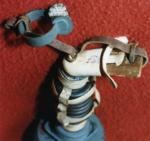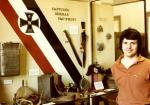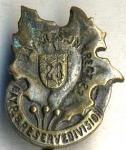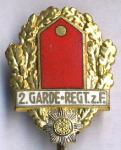-
Posts
2,962 -
Joined
-
Last visited
Content Type
Profiles
Forums
Blogs
Gallery
Events
Store
Everything posted by Chip
-
That gray NCO Borte with the white stripes came out in the fall of 1915, just about the time the Hellgrau piped boards were about to be superceded. So they are contemporary. My guess is that this tunic dates from the fall of 1915 or early 1916. It could date from a later time, however, as the latitude for following regulations was pretty wide in the air service. Chip
-

M16 Austrian Style
Chip replied to Jason's topic in Germany: Imperial Uniforms, Headwear, Insignia & Personal Equipment
I think I can see the metal grommets. Looks 100% to me. Very nice. Chip -
Glenn, Well, as you can imagine, the Wappenadler threw me off course. I must have spent nearly two hours going through my references trying to figure it out. When I could come up with no exact match, I had to go with what seemed to me to be the closest. I should have guessed it would be a trick question! Just goes to show you what digging through the archives can turn up. Great information! Chip
-
Speaking of gas masks, here is one of my favorites. It really is not a "mask", but rather is worn in conjuction with a pair of goggles. Made by Draeger, but I have never seen any regulations about or descriptions of this apparatus. The height of the carrying can is 24.5cm tall (9 5/8") and has a diameter of 10cm (4"). The device hangs up-side-down in the can, that is, the mouthpiece and hose end are dropped in first, with the filter canister going in last. The canister is suspended by a lip on the inside of the can that keeps it from going further inside. This, in effect, allows the hose to dangle free inside and keeps it from being crushed. It has the standard three loops for the shoulder sling and belt support strap. The inside is lined in corrugated cardboard (sides and bottom). There is no compartment in the lid. I have a picture of one being worn. Anyone know who wore these? I will show the photo later if I get a correct answer or if no one replys. Chip
-
Glenn, I will step out on a limb since no one else has. The only thing that is throwing me off is the black collar and cuffs with the gold Litzen. I thought I had found it, but the black I saw, actually said Dunkelblau Samt in the text. Anyway, I am going to guess that the color is really Dunkelblau and that it is the uniform of a Vortragender Rat der 3.Rangklasse (one pip) des Kriegsministeriums (carmine red) and with a twist he would have to be a Beamte des Beurlaubtenstandes (for the Landwehr Cross). In other words, a high official of the War Ministry, who is not with the colors (on furlough). Chip
-
Dan, Your straps are from the Hessian Leibgarde Infanterie Rgt. Nr.115. The cypher is that of Ernst Ludwig, who had been the Grand Duke of Hesse since 1892. The regiment traced its lineage back to 1621. It was garrisonned at Darmstadt and was part of the XVIII Army Corps. They appear to be issue quality straps, but they have no button holes that I can see, so my guess is that they were unfinished and at some point in the past, someone decided to complete them. This would account for the mismatched backing material, the aforementioned lack of button holes and the rather irregular sewing and edges. These things just don't look right for an issued shoulder strap. Everything else appears original, so maybe a blacklight would tell you if they have been assembled since the 1960s. I could be wrong about that, but regardless, they are nice shoulder straps. Chip
-
Hello Dan, The military official's boards are most likely from the Garnisonverwaltung (light blue underlay). The collar tabs match the description of the tabs for the Litewka, but I don't believe the tabs had pips during the imperial era, at least there is no picture or mention of pips in Kraus. Chip
-
Chris, The Bavarian M16 Bluse had a collar that was the same feldgrau wool as the rest of the tunic. Starting in October 1916 issued pieces had the Bavarian Kennzeichenborte completely around the low edge of the collar. By December of 1917 this braid was reduced to just a short strip on the front vertical part of the collar. By war's end, this braid was often missing altogether. Regarding the removal of shoulder straps for raids, I would think it would be fairly easy for most officers had removable boards. The only straps that were routinely sewn into the shoulder seam, were Bavarian straps. You often see M1916 Bavarian straps with unfinish ends (not sewn shut acrosss the bottom edge), as they were just going to be hidden inside the seam anyway. I don't see how these straps could be easily removed and put back into place. All other post-1914 made enlisted straps were top stitched on, so they could easily be removed, but would have had to be reattached later. A little more work, but you do as you are told. Other than the aforementioned Bavarian straps, you also encounter shoulder straps sewn into the shoulder seam on custom purchase tunics or issue tunics that have been altered due to a soldier being promoted. Often these "improved" issue tunics are set back for off duty wear and thus the removal of straps is not necessary. Our national WWI museum in Kansas City has a mint condition field water carrier. It was part of the large cache of captured war material that was split amongst the states according to the percent of troops that it contributed to the war effort. The state was offered a large list to choose from. The stuff on it is amazing. Compared to what it could have taken, the state of Missouri took only a moderate amount of things. The water carrier is painted feldgrau and has shoulder straps made from papercloth, so it can be carried on the back, like a pack. You can see it here in a display at the museum from 1978. Chip [attachmentid=35002]
-
dond, Sorry for the delay. I like these regimental pins too. There are more and more collectors bidding on them these days (I guess you can say that about any militaria!), so they are getting a bit pricey. I have had three of these for many years and the other three have come to me since the advent of ebay. Some are more common than others. You may well have seen examples of some of these, while others are quite scarce. The second from the left is the cypher of the 3.bayr.I.R., the same one that the regiment wore on their shoulder straps until 1916, when it was changed. Sizes are not relative. I was experimenting. The J?ger pin is for the 5th J?ger Batl. The final piece consists of the regimental cypher of the 80th F?silier Rgt. superimposed over a starburst with Hessian lion in the center. [attachmentid=34903][attachmentid=34904][attachmentid=34905][attachmentid=34906][attachmentid=34908]
-

M15 Feldbluse
Chip replied to Chris Boonzaier's topic in Germany: Imperial Uniforms, Headwear, Insignia & Personal Equipment
Chris, 700 Euro sounds very expensive for something that isn't identified. Chip -
Rick, I like the personal history stuff too, but another thing that I find of particular interest is the little geometrical designs in the upper corners of this document. The 267.FAR as part of the 208th, so-called "Strich-Division", wore this design as a unit insignia on the left lower arm of their tunics. The triangle over a horizontal stripe, both in white cloth, were worn from the summer of 1917 on. Supposedly, these insignia were also painted on the back of their helmets as well. Here is a scarce photo of the insignia being worn by a soldier from the regiment (photo courtesy C.Wagner). Chip
-

M15 Feldbluse
Chip replied to Chris Boonzaier's topic in Germany: Imperial Uniforms, Headwear, Insignia & Personal Equipment
Chris, Any pictures coming? Chip -

Rank Buttons?
Chip replied to notned's topic in Germany: Imperial Uniforms, Headwear, Insignia & Personal Equipment
You might get some clue from any maker information on the back, though often the manufacture of military buttons was farmed out to other countries. The eagle buttons are all Polish. The one on the bottom right looks similar to a French artilllery button, but this motif is pretty common for artillery, so it may well be Polish too. Chip -

Canteen cups
Chip replied to Chris Boonzaier's topic in Germany: Imperial Uniforms, Headwear, Insignia & Personal Equipment
While I agree that this cup is most likely from a later period, I don't see any definitive reason why it could not be from the WWI period. In my experience, these cups came with manufacturer's marks and dates, with manufacturer's marks and no date or with no markings at all. The rivets are a bit different, but that could easily be chalked off to manufacturer's peculiarities. As an example of existing peculiarities, most of these aluminum cups had pour spouts, but a fair amount of them (like Daniel's example) did not. We don't know why. I have four marked aluminum cups. Three have dates (1910, 1911 and 1914) and the fourth is not maker marked, but does have a unit marking (104R.). I have yet to see what I could call a definite wartime dated example (that is, 1915 dated). They should exist, as the tinned steel version did not arrive until June of 1915. It is unclear what was being manufactured between the orders for the end of the use of aluminum in October of 1914 and the first Probe pieces of the tinned steel version, though I suspect the aluminum pieces had to be continued until the substitute was ready. There was a canteen cup during WWI and it was found on the Labeflasche (Sanit?ter canteen), strapped to the top. The cups were originally made from aluminum, but were changed to tinned steel in the summer of 1915. Chip













